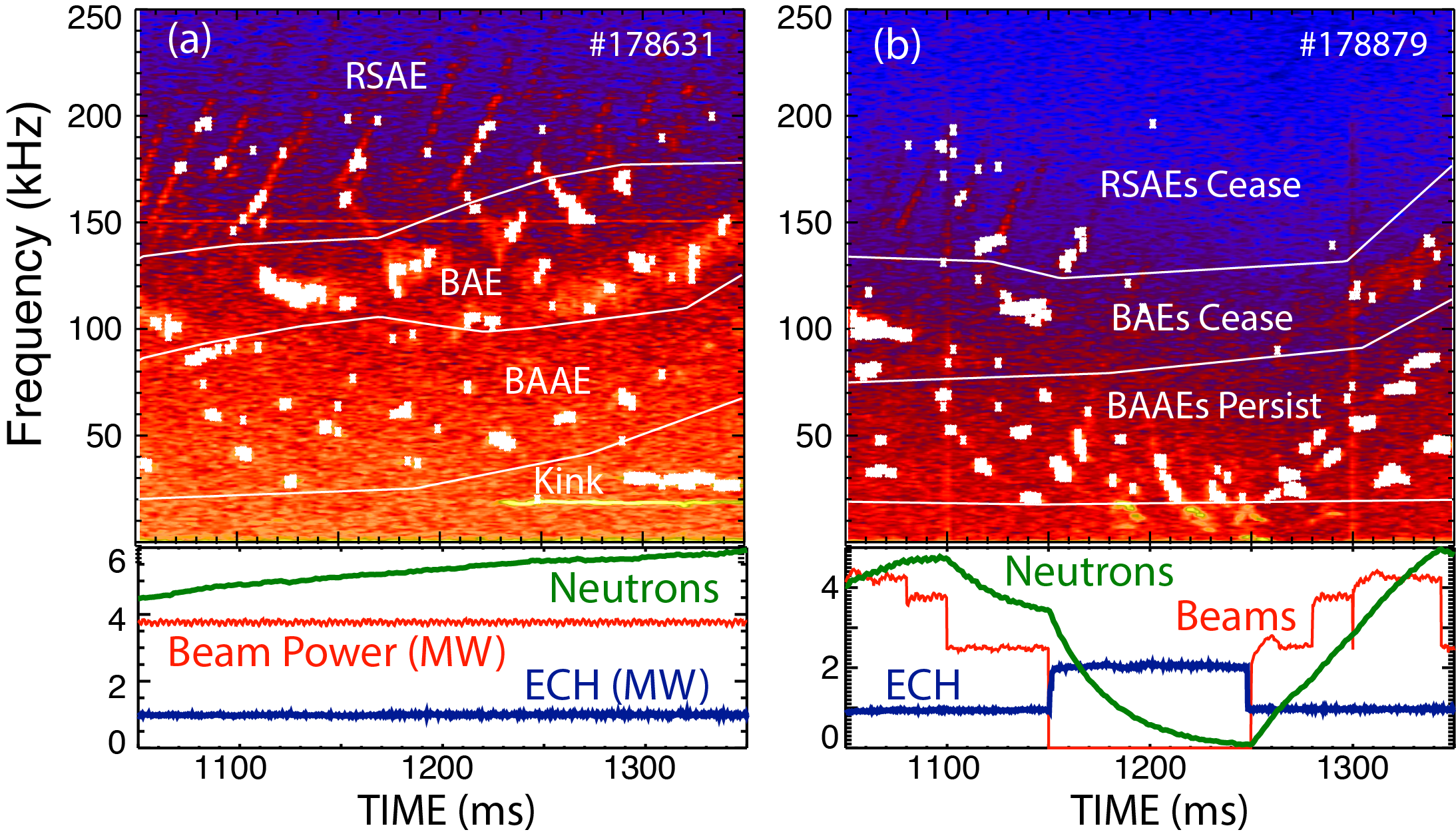Speaker
Description
Contrary to previous thinking, recent experiments on DIII-D suggest that the low-frequency instability known as the beta-induced Alfvén-acoustic eigenmode (BAAE)$^1$ will not degrade high-energy fast-ion confinement on future devices. On the other hand, another low-frequency instability, the beta-induced Alfvén eigenmode (BAE)$^2$, interacts strongly with the high-energy fast-ion population and remains a threat.
Deuterium neutral beam injection (NBI) drives BAAE, BAE, and reversed-shear Alfvén eigenmode (RSAE)$^3$ instabilities (Fig. 1a). When the NBI and electron cyclotron heating (ECH) patterns are held constant, the AE activity (and q profile evolution) is highly reproducible at the time of interest. Transient changes in heating isolate the driving gradients for the instabilities. When the NBI heating is altered, the BAE activity rapidly changes (Fig. 1b) in a time much shorter than the ~100 ms slowing-down time, indicating that high-energy ($E_{beam}\sim80$ keV) beam ions drive the BAEs unstable. In contrast, BAAE activity persists even in the absence of NBI. Even though the neutron rate decays to <5% of its previous value, the BAAEs remain unstable, indicating that fast ions with energies above ~30 keV are not driving the BAAEs. In other discharges, the angle of beam injection was changed from tangential to perpendicular at approximately constant NBI power. The frequency of BAE activity increased but BAAE activity was hardly affected. Calculations of the resonance condition $\omega=n\omega_\phi+p\omega_\theta$, where $\omega_\phi$ and $\omega_\theta$ are the toroidal and poloidal orbital frequencies of recently injected beam ions, show that the increase in frequency $\omega$ allows perpendicular beam ions to resonate with the BAE. (Here, n is the toroidal mode number and p is an integer.)
The intermittent appearance of RSAE, BAE, and BAAE activity in Fig. 1 occurs because all three modes are sensitive to the q profile, which continuously decreases during the illustrated time. Electron cyclotron emission (ECE) and beam emission spectroscopy (BES) diagnostics show that the radial eigenfunction for all three modes peaks near $q_{min}$. Unlike RSAEs and BAEs, the BAAEs are undetectable on Mirnov coils, suggesting less electromagnetic polarization for these modes.
In addition to a database of the 20 shots in the dedicated experiment of Fig. 1, a database of over 1000 DIII-D discharges with ~ 2500 entries has been compiled. For each entry, RSAEs, BAEs, and BAAEs (as well as TAEs and EAEs) are classified as stable, marginal, or unstable. In both databases, BAAE activity occurs most often in plasmas with large electron temperature $T_e$ but relatively modest beta (Fig. 2a). Since the BAAE is expected to have an acoustic component to its polarization, these dependencies may reflect an underlying dependence on ion Landau damping, which is enhanced at low $T_e$ and in plasmas with large ion pressure. As expected from the dedicated experiment, the dependence on NBI parameters in both databases is very weak for the BAAE.
In contrast, BAEs occur more frequently as the poloidal beta $\beta_p$ increases (Fig. 2b) and in plasmas with more beam power and parallel beam beta. For $\beta_p>1.5$, the occurrence of BAEs is comparable to the occurrence of TAEs, highlighting the importance of predicting BAE stability in Advanced Tokamak reactor scenarios.
Initial comparisons of gyrokinetic (GTC and LIGKA) and gyrofluid (FAR3D) codes against the data of Fig. 1 are encouraging. GTC finds a linearly unstable mode with frequency and mode structure similar to the experimental BAE; an unstable mode with BAAE frequency is only found in simulations without beam ions. Preliminary nonlinear simulations indicate that zonal flows cause the saturation of the unstable BAE. After benchmarking, these codes will predict BAAE and BAE stability in ITER.
Work supported by US DOE under DE-FC02-04ER54698 and DE-SC0020337.
$^1$N.N. Gorelenkov et al., Phys. Lett. A 370 (2007) 70.
$^2$W.W. Heidbrink et al., Phys. Rev. Lett. 71 (1993) 855.
$^3$S.E. Sharapov et al., Phys. Lett. A 289 (2001) 127.


| Affiliation | University of California, Irvine |
|---|---|
| Country or International Organization | United States |
